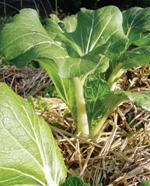Jane Bellerby and Ginny Clayton woudln't be without two veggies in their winter kitchen gardens – Pak Choi and Miner's Lettuce.
Miner’s Lettuce
Making winter salads interesting and enticing can be a challenge because so many traditional salad vegetable are summer crops.
This is why miner’s lettuce (Claytonia perfoliata) – also called winter purslane, spring beauty or Indian lettuce – is such a favourite in our household. Miner's lettuce has a high vitamin C content. This quality won this humble plant a reputation for countering scurvy.
It also gave it its name. Itinerant gold miners, aware of the health benefits of this easy-to-grow green, carried seed with them, colonising the plant during successive goldrushes.
 Today, vegetarians also find this plant invaluable in their diet for another reason: it is a source of essential omega 3 fats Miner's lettuce has a pleasant flavour, somewhere between lettuce and spinach but a little sweeter. Children are fascinated by its succulent looking leaves, shaped a bit like a snake's head, and may be persuaded to pick and eat it straight from the plant. Picked as a come again salad green, it can grow into quite a large plant and, unlike many vegetables of a similar ilk, its older leaves don't become bitter with age. The leaves are also delicious steamed with spinach or beets, or in added to stir-fries towards the end of cooking.
Today, vegetarians also find this plant invaluable in their diet for another reason: it is a source of essential omega 3 fats Miner's lettuce has a pleasant flavour, somewhere between lettuce and spinach but a little sweeter. Children are fascinated by its succulent looking leaves, shaped a bit like a snake's head, and may be persuaded to pick and eat it straight from the plant. Picked as a come again salad green, it can grow into quite a large plant and, unlike many vegetables of a similar ilk, its older leaves don't become bitter with age. The leaves are also delicious steamed with spinach or beets, or in added to stir-fries towards the end of cooking.
Miner’s lettuce is easily grown from seed (the seed is small, round and shiny). Although a tray can be used, it is best sown directly into the garden. Miner's lettuce has a taproot and if it is grown in trays it should be transplanted when the seedlings are small, before the root develops. If it is sown into the plot directly, thinning can be left until the leaves are big enough to be eaten.
Sow by sprinkling seed thinly on top of the soil and pressing it in without covering. If you grow it as a border two rows wide ringing a veggie patch, it is readily accessible and also looks attractive. You can also try growing it in tubs or pots with parsley and other salad greens. It will tolerate moderate frost and can be grown throughout winter. If you have sandy or loamy soil and let it self-seed, you'll have it forever.
Pak Choi
 Pak Choi is a quick growing, short season vegetable with a wide variety of culinary uses. Even at this chilly time of year seeds can be sown in temperate zones and it will flourish despite moderate frost.
Pak Choi is a quick growing, short season vegetable with a wide variety of culinary uses. Even at this chilly time of year seeds can be sown in temperate zones and it will flourish despite moderate frost.
As you might expect of a plant cultivated for thousands of years, plant breeders have bred various types of pak choi suitable for specific uses. For example, purple flowering pak choi – which can produce more than 20 flowerheads a plant – is grown for the flower stalks often used in stir fry dishes.
A recent addition is Qin Tah Tsai F1. It has deeply veined, dark succulent leaves and is ideal for year-round cropping. It may be picked 30 days from sowing or left to grow to full harvesting size.
Another variety, the mellow-flavoured Joi Choi F1 grows upright, has excellent cold tolerance and is disinclined to bolt. For hotter weather there’s Cash F1.
It’s easy to let these quick growing greens get past their best so pick them young and make successive plantings to ensure a steady supply.
Pak choi likes soil well prepared with compost and animal manures, such as chicken and sheep pellets. It also responds to a pH of about 5.6 to 6.5, so lime our soil accordingly.
Prepare the seedbed with a fine layer of soil along the drills or over the top of your container. Sow seed thinly in rows, aiming for a final spacing of about 15cm between plants. Cover with fine soil to a depth of about 1cm and moisten. At this time of year, avoid heavy watering and give it full sun. In summer, however, you are best advised to grow pak choi in a cooler spot. Once the seedlings are up and a few centimetres high, you can thin them and transplant the thinnings.
White butterfly and the diamond-backed moth will enjoy your pak choi as much as you do. Cover your pak choi with netting to ward off these pests or use the organic spray Bacillus thuringiensis (Bt), a successful, environmentally friendly, microbial insecticide.
You can harvest pak choi leaves 4-6 weeks from the time of sowing and enjoy them in winter and spring salads and in stir fries.
Copyright © Weekend Gardener: www.weekendgardener.co.nz
For subscriptions and further infomation please go to the Weekend Gardener website.










Join the Discussion
Type out your comment here:
You must be logged in to post a comment.